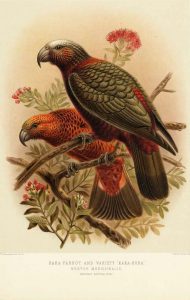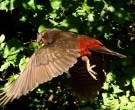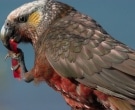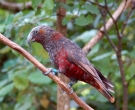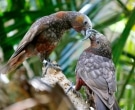Content |
|---|
Description
45 cm.. length and an average weight of 550 g..
The New Zealand Kaka (Nestor meridionalis) they are some great parrots with a tail of medium length and a plumage predominantly Brown and Red.
The adult male has the crown whitish grey color and the neck with a greyish Brown appearance due to large brown feathers that surround you.
The under eye and the sides of the neck has a bluish grey clear. The lores are greyish Brown, that contrast with the ear-coverts strongly tinged with orange. The sides of the chin they have reddish-brown infiltrations.
The feathers of the upperparts are greenish Brown with darker stripes and stripes. Those in the back of the neck They are crimson red with yellow endings and browner bases..
The the mantle, sometimes, has some red spots. Rump and uppertail-coverts are red with dark brown trim. The lower area of the wings and axillary they are also red.
The feathers of the chest are olive brown in colour with reddish edges subterminales. Belly and undertail-coverts are red with dark edges.
The tail is brown with lighter tip.
The bill is brownish grey, more powerful that the of the Kea. The cere Brown it is decorated with a few whiskers. The irises is dark brown, legs dark gray.
The adult female presents a bill shorter and one mandible less curved top.
The youth they are similar to adults, but have a small yellow spot at the base of the lower jaw.
- Sound of the New Zealand Kaka.
Subspecies description
- Nestor meridionalis meridionalis (Gmelin, 1788) – Nominal species
- Nestor meridionalis septentrionalis (Lorenz von Liburnau, L 1896) – It measures 42 cm approximately. Variation of the nominal (Nestor Meridionalis). More small, in general, and plumage more off. The red band of the neck is more small and dark. The back of the wings olive color is more dark.
Habitat:
The New Zealand Kaka (Nestor meridionalis) they frequent the compact forests of low to medium height, where there are mainly podocarp and beech trees of the genus Nothofagus. Occasionally they come into gardens and orchards, especially in winter.
These birds they tend to live at altitudes between 450 and 850 meters in the summer and from the sea level to the 550 meters in winter. But, from time to time, You can climb up to the 1.500 m.
The New Zealand Kaka they live in pairs or in small groups of up to ten birds.
These birds are not as well known as the Kea (Nestor notabilis), Although in some places come to feed in the hand of the tourists.
We can often see them at the top of trees or simply flying over the canopy.
The birds that are found in the air almost always heard before to be seen.
The New Zealand Kaka they are active during the morning and afternoon. At the hottest time of the day, around midday, They lie between the foliage of the trees.
Around the darkness, they perform a series of acrobatic flights, before returning to their roosts. Screams and calls can be heard well into the night.
In some areas, the New Zealand Kaka they are sedentary. But, most of the time they are erratic or perform short altitudinal migrations. These birds are able to fly long distances. They fly to vigorous banging of wings.
Reproduction:
The season of nesting is from September to March, but it is above all active between November and January.
The nest is located in a tree cavity between 3 and 9 meters above the ground. The pair sometimes enlarges the entrance hole with its beak..
The spawning contains 4 or 5 eggs white. These are deposited on a layer of sawdust that covers the bottom of the cavity.
The incubation, that lasts a few 24 days, It is done solely for the female. She leaves the nest at dawn and dusk to be able to be powered by your partner. an assistant, sometimes, can participate in the feeding of the female during the period in which she incubates.
In the North, the young have white down, While the of the South they have grey down at the bottom.
The juveniles they acquire their full plumage in ten weeks.
For the duration of the stay in the nest, they are fed by both parents.
The breeding success rate is relatively low and they rarely lay more than one egg per year..
Food:
The New Zealand Kaka It has a long tongue terminated tip, What helps you to extract nectar from the flowers and to collect molasses.
In the Spring, in the South of the island, the New Zealand Kaka almost passes the 30% of their time in the trees (Beech) where feeding of honeydew produced by the local cochineal (Ultracoelostoma assimilates). In other stations, This food is a less important resource due to competition with the WaSP, which is also a great consumer.
The larvae of beetles of long antennae they are also a good source of nutrition.
Throughout the year the New Zealand Kaka, regularly, frequent trees, where it used its powerful curved beak to hunt insects hidden beneath the bark.
When opossum populations disperse, the New Zealand Kaka they spend nearly the 60% of their time feeding on flowers and berries. It also, consume sprouts, seeds, nectar and SAP.
Distribution:
Size of the area of distribution (reproduction / resident): 71.100 km2
This species is endemic of New Zealand.
Subspecies distribution
- Nestor meridionalis meridionalis (Gmelin, 1788) – Nominal species
- Nestor meridionalis septentrionalis (Lorenz von Liburnau, L 1896) – Endemic to North Island (New Zealand), survives in large forest areas of the Coromandel Peninsula to Wairarapa, and is moderately common only in the forests of Pureora and Whirinaki and some coastal islands
Conservation:
• Current Red List of UICN: Danger
• Population trend: Decreasing
This species has a very irregular distribution. in most places, is rather sparse, but in other places, is common locally, especially in some coastal islands.
Its population It is estimated between 3750 and 15,000 specimens.
The main threat is the habitat degradation. It stays within primary forest fragments, showing its very low adaptation to artificial habitats.
The New Zealand Kaka not nest every year in a systematic way. When I was try to reproduce in captivity, the success rate was not very high (on average the 56% eggs not hatched ).
Clutches often suffer from the predation on the part of the weasels It was introduced on the island. For all these reasons that the species is classified as VULNERABLE.
"New Zealand Kaka" in captivity:
Very rare in captivity.
In terms of their longevity, according to sources, a specimen in captivity lived during 15 years.
Taking into account the longevity of the similar species, the maximum longevity of these birds might be underestimated. Other sources indicate that these birds can live up to the 35,5 years in captivity, something that is plausible, pero que no ha sido verificado; el mismo estudio informó que los New Zealand Kaka can reproduce a partir de los 7 years of age in captivity.
Alternative names:
– New Zealand Kaka, Common Kaka, Kaka (English).
– Nestor superbe (French).
– Kaka (German).
– Kākā (Portuguese).
– Kaka (español).

scientific classification:
– Order: Psittaciformes
– Family: Strigopidae
– Genus: Nestor
– Scientific name: Nestor meridionalis
– Citation: (Gmelin, JF, 1788)
– Protonimo: Psittacus meridionalis
Images “New Zealand Kaka”:
Videos "New Zealand Kaka"
————————————————————————————————
“New Zealand Kaka” (Nestor meridionalis)
Sources:
– Avibase
– Parrots of the World – Forshaw Joseph M
– Parrots A Guide to the Parrots of the World – Tony Juniper & Mike Parr
– Birdlife
– Photos:
(1) – Car (Nestor meridionalis) in Wellington, New Zealand By derivative work: Snowmanradio (talk)Kaka_(Nestor_meridionalis)-_Wellington_-NZ-8.jpg: PhillipC [CC BY 2.0 or CC BY 2.0], via Wikimedia Commons
(2) – North Island in Kaka, at Auckland Zoo, New Zealand By Small [CC BY-SA 2.0], via Wikimedia Commons
(3) – A New Zealand Kaka in Karori Wildlife Sanctuary, Wellington, North Island, New Zealand By Rosino (the colorful kākāUploaded by Snowmanradio) [CC BY-SA 2.0], via Wikimedia Commons
(4) – Nestor meridionalis meridionalis, South Island Turkey, on Stewart Island, New Zealand By derivative work: Snowmanradio (talk)Kaka-parrot_-Stewart-Island.jpg: giles.breton [CC BY 2.0 or CC BY 2.0], via Wikimedia Commons
(5) – Kaka in flight. Karori Wildlife Sanctuary, Wellington, New Zealand. I, Tony Wills [CC BY-SA 3.0], via Wikimedia Commons
(6) – Illustration of a Kaka By J. G. Keulemans, in W.L. Buller’s A History of the Birds of New Zealand. 2nd edition. Published 1888. (New Zealand Electronic Text Centre) [CC BY-SA 3.0 nz], via Wikimedia Commons
– Sounds: Fernand DEROUSSEN (Xeno-canto)

